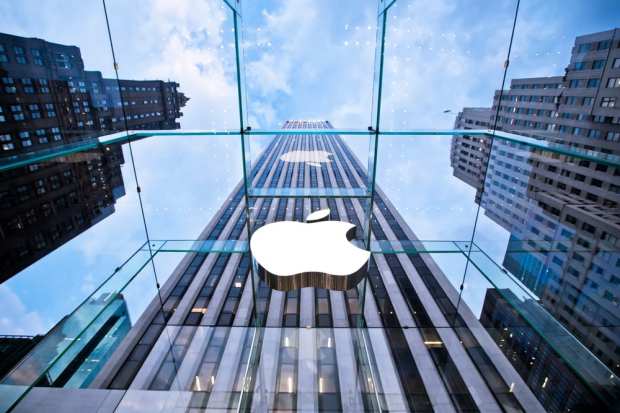Apple CEO Says Apple Card, Installment Plans Juiced iPhone Sales

The iPhone was back in the earnings spotlight as Apple reported record sales for its flagship device when its FY Q1 earnings hit the wires. But the iPhone wasn’t the only Apple product that had a strong finish to the 2010s however, in what CEO Tim Cook described as a “blockbuster quarter all the way around.” Apple also logged record-breaking performance from its Services and wearable offerings — with Apple Music, Apple Care, The App Store, Apple Pay, The Apple Card, The Apple Watch and Airpods all getting a shout out from the CEO during his call with analysts after the numbers went public.
“As we close the book on 2019 we are well underway on some new and exciting development of the future,” Cook told analysts, noting that Apple’s “boundless creativity and innovation” will be no different in the new year and new decade than they have been. He did, however, decline when asked by several analysts to elaborate on what new developments exactly were going to be the beneficiaries of all that boundless innovative creativity.
But it looks like on the bright side, at least, the iPhone will not need a replacement in its position as the driver of the Apple revenue machine. In stark contrast to this time last year, when Apple was forced to revise its revenue guidance down due to weaker than forecast performance in Greater China, this year, Apple reported revenue up 9 percent to $91.8 billion, well ahead of the $88.50 billion estimated. Leading that revenue growth as a stronger performing than expected iPhone, which saw its revenue count up 8 percent year-on-year to $55.96 billion, again well ahead of the $51.62 predicted.
A large portion of that growth, noted Cook, was attributable to the fall 2019 rollout of the Apple Card paired with Apple’s offer of 24 interest-free monthly installment payments for iPhone purchase. Cook noted that Apple’s three most popular selling phones during the holiday quarter in the U.S. were its three newest releases, “and the Card was clearly a crucial driver in creating an incentive as many iPhone customers were looking for to upgrade.” It also helps that during the holiday season, Apple also offered 5 percent cash back on all purchases made in the Apple Store — including phone purchases made using installments.
But while the iPhone was the win that caught headline writers’ eyes, it was not the only outcome announced. Services had a record-breaking quarter but came in below analysts’ expectations with $12.7 billion in revenue instead of the $13.01 forecast. But Apple did note a record number of paid subscribers to its various services by the end of 2019 such that it is on pace to hit its 500 million subscriber target for 2020 in the first half of the year and have thus revised it up to 600 million. Cook also called out Apple News’ 100 million active monthly users, Apple TV+ launch and recent awards wins/nominations, the Apple Arcade gaming service and Apple Pay’s continued integration into transport systems around the world. Cook noted that this penetration would likely pick up the pace later in 2020 when the ability to tap and pay via Apple Watch will be emerging in some transport hubs globally.
That ended up being Cook’s segue into the wearables portion of the presentation, housed in Apple’s “other” category of which brought in $10 billion in revenue ahead of the $9.52 billion estimate pre-release. Cook said that on its own, Apple’s Other Products would constitute a Fortune 150 company. Both the Apple Watch and AirPods, he noted, had a particularly successful close to 2019, as both were hot holiday gift items this year.
“And we are seeing our Wearable category expand with 75 percent of Apple Watch customers during the last quarter being totally new to Apple Watch,” Cook told investors and analysts.
The quarter also saw a return to growth in its Greater China segment, which also includes Taiwan and Hong Kong in the quarter which ended in December. Though China — and the recent outbreak of the Wuhan coronavirus in China has introduced some uncertainty into its FYQ2. Cook told investors that from a production standpoint, Apple does have some facilities within the Wuhan region that will be affected by shut-down, but that it has mitigations in place to relocate that capacity. As for the bigger picture in the surrounding regions, Cook noted, the situation is less clear what the effects will be — past the fact that they know that the New Year’s closures will be in effect until Feb. 10.
Cook said on the consumer side, they have closed an Apple retail store in China, and at least some of their channel has done so with storefronts as well. However, what the effect that will have on retail sales in the region remains hard to quantify while the coronavirus continues to spread. This pushed Apple to offer wider than normal guidance range for Q2 — as unknowns about the situation are coming into focus. For the next quarter, Apple’s revenue guidance ranges from $63 billion to $67 billion vs. $62.45 billion forecast
“As you can see, we anticipate some level of issue there. Otherwise, we would not have a $4 billion range,” Cook said.
And while uncertainty looms, the market was certainly happy with Apple’s nearly across the board beat on expectations. Stock prices shot up 3 percent in after-hours trading.
